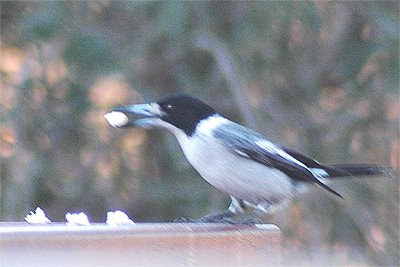There were Honeyeaters galore in the trees in Caroline's backyard. Her house sits atop the cliffs of the Cataract River Gorge. There are many Gum Trees along this top edge of the gorge, and, many other native trees and plants down below, in the gorge itself, of course.
The first birds I noticed were the Yellow-faced Honeyeaters, and Little Wattlebirds, and a family of Superb Fairy Wrens ("Blue Wrens"). We sat on the back deck and had a coffee, and listened to the Striated Pardalotes in the trees (always hard to see, while feeding on Lerps on the Eucalypt leaves.) Eastern Spinebills flipped past us, their noisy wing-beats attracting our attention.
Caroline and I then drove past Appin, and went for a walk to the Georges River. We heard Whipbirds calling in the dense shrubbery, as we approached the river. Once we got there, I noticed some frogs calling (but not many). But it was the birds which I was most conscious of. The Yellow-faces were still around, but there were other Honeyeaters, including the wonderfully bright Yellow-tufted Honeyeater, and the ever-present New Holland Honeyeaters. Those birds love Banksias and Grevilleas, both of which were in flower. I saw a female Golden Whistler, and a Grey Shrike Thrush. Two Black Ducks were swimming fitfully on the river, near some reeds.
The highlight for me was hearing (could I believe my ears?) what I thought sounded like the call of the Peaceful Dove. I have not seen this species in more than 20 years. And when I did, it was in central NSW, near Forbes and Dubbo. Could they be here, on the edge of the Sydney Basin?
Sure enough, after a few minutes of walking along the banks of the Georges River, I saw first one Dove, and then, a pair of them, sitting on a dead shrub across the river.
 These are lovely birds, with a quiet, non-aggressive nature, and a quiet voice. So much "nicer' than the aggressive New Holland Honeyeaters
These are lovely birds, with a quiet, non-aggressive nature, and a quiet voice. So much "nicer' than the aggressive New Holland Honeyeaters This photo is not great, but it is diagnostic. You can just make out the blue eye ring, and the fine markings on the back and neck. Definitely not the introduced Turtle Dove.
This photo is not great, but it is diagnostic. You can just make out the blue eye ring, and the fine markings on the back and neck. Definitely not the introduced Turtle Dove.As we walked back up to the road, I noticed a grassy glade, which looked promising for Greenhoods. Sure enough, there were many large leaves of a Greenhood in this moist soil. After looking around I found two open flowers of the Blunt Greenhood (Pterostylis curta).
It has a lovely shape from side on.
 And from the front view you can clearly see the diagnostic twisted labellum (tongue).
And from the front view you can clearly see the diagnostic twisted labellum (tongue). Back at Caroline's a beautifully marked Pied Butcherbird landed in the tree, while I was on the phone talking to Bernie.
Back at Caroline's a beautifully marked Pied Butcherbird landed in the tree, while I was on the phone talking to Bernie.  I whispered to Caroline that the Butcherbird was here, and straight away she went and got some pieces of bread and put them on the deck railing. Clearly the Butcherbird has got Caroline trained, and it rewarded her by zooming straight in and grabbing a morsel immediately.
I whispered to Caroline that the Butcherbird was here, and straight away she went and got some pieces of bread and put them on the deck railing. Clearly the Butcherbird has got Caroline trained, and it rewarded her by zooming straight in and grabbing a morsel immediately. This snatch and grab movement was so fast I only had a moment to point and shoot. No chance to adjust shutter settings, before the bird was off. But you can see what good plumage it had. Clearly an adult male.
This snatch and grab movement was so fast I only had a moment to point and shoot. No chance to adjust shutter settings, before the bird was off. But you can see what good plumage it had. Clearly an adult male.Late in the afternoon, the Noisy Miners had moved in and chased away the other Honeyeaters. But they did not disturb a pair of King Parrots feeding on the Wild Tobacco Plant (Solanum mauritianum).
As a late-afternoon bonus, a family of 8 Yellow-tailed Black Cockatoos flew out of the Gorge, below us, and flew to a neighbouring Pine Tree. The younger members of the group then started their droning noises, while waiting for the adults to feed them. Who would be a parent?

No comments:
Post a Comment